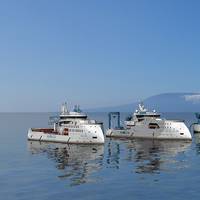Arctic (& Wind) Operations: Hands Across the Water

As the North American offshore wind model evolves, it is clear that fit-for-purpose, Jones Act compliant and Arctic ready tonnage will need to be part of the equation. If so, we’ve got that box checked, with a little help from Europe.As of September 2018, the Walney Extension off the United Kingdom is the largest offshore wind farm in the world at 659 megawatts. There are at least 70 major wind farms, each with hundreds of wind turbines, each generating as much as 10 megawatts in offshore England, the North Sea, Russia and China.
AWI to Track Carbon Particles in the Arctic
On 15 March, the AWI research aeroplane Polar 5 will depart for Greenland. Concentrating on the furthest northeast region of the island, an international team of researchers will spend the next four weeks studying how the Arctic is changing. In the course of the PAMARCMiP campaign they will measure the sea ice and the atmosphere between Greenland and Svalbard – on the ground, using a tethered balloon, and from the air. Their primary target: carbon particles. Historically, Greenland isn’t exactly considered to be prone to wildfires. But last summer a fire broke out in the moors on the western half of the island, eventually covering several square kilometres. Satellite images revealed the massive smoke clouds.
Arctic Route Helps Owners Slash Fuel Costs

The debate regarding working in and around the Arctic is multi-tiered, with environmental, technical and emergency response heading the list. There is no debate regarding the fuel, money and emissions to be saved by shortening select global shipping routes. In a report from Bloomberg news posted June 13 on http://www.businessweek.com, it was said there will be a rise in dry bulk cargos hauled through Arctic waters this season, a journey that can halve shipping time compared to some Suez Canal shipments, and simultaneously reduce fuel consumption, costs and emissions.
The Arctic: Economic Promise or Environmental Peril?

The fervor to move shipping routes and energy business north of the Arctic Circle is palpable, as countries with physical connection and even ‘non-Arctic’ states are making moves and plans to stake claims to the vast potential that lies within. While the maritime and subsea technology allowing ops in the Arctic’s harsh environs has moved forward fast, there are repeated and regular ‘warning shots across the bow’ of budding entrepreneurs large and small, as the Arctic environment is still largely undeveloped territory, representing risky operations for even the heartiest of souls.
This Day in U.S. Coast Guard History – October 25
1941-South Greenland Patrol expanded to include 3 cutters of the Northeast Greenland Patrol and form the Greenland Patrol. 1985-CGC Polar Sea arrived home to Seattle after a voyage through the Northwest Passage by way of the Panama Canal, the east coast, and then Greenland, sparking an international incident with Canada. She completed the first solo circumnavigation of the North American continent by a U.S. vessel and the first trip by a Polar-Class icebreaker. She also captured the record for the fastest transit of the historic northern route. She had departed Seattle to begin the voyage on 6 June 1985. (Source: USCG Historian’s Offiice)









